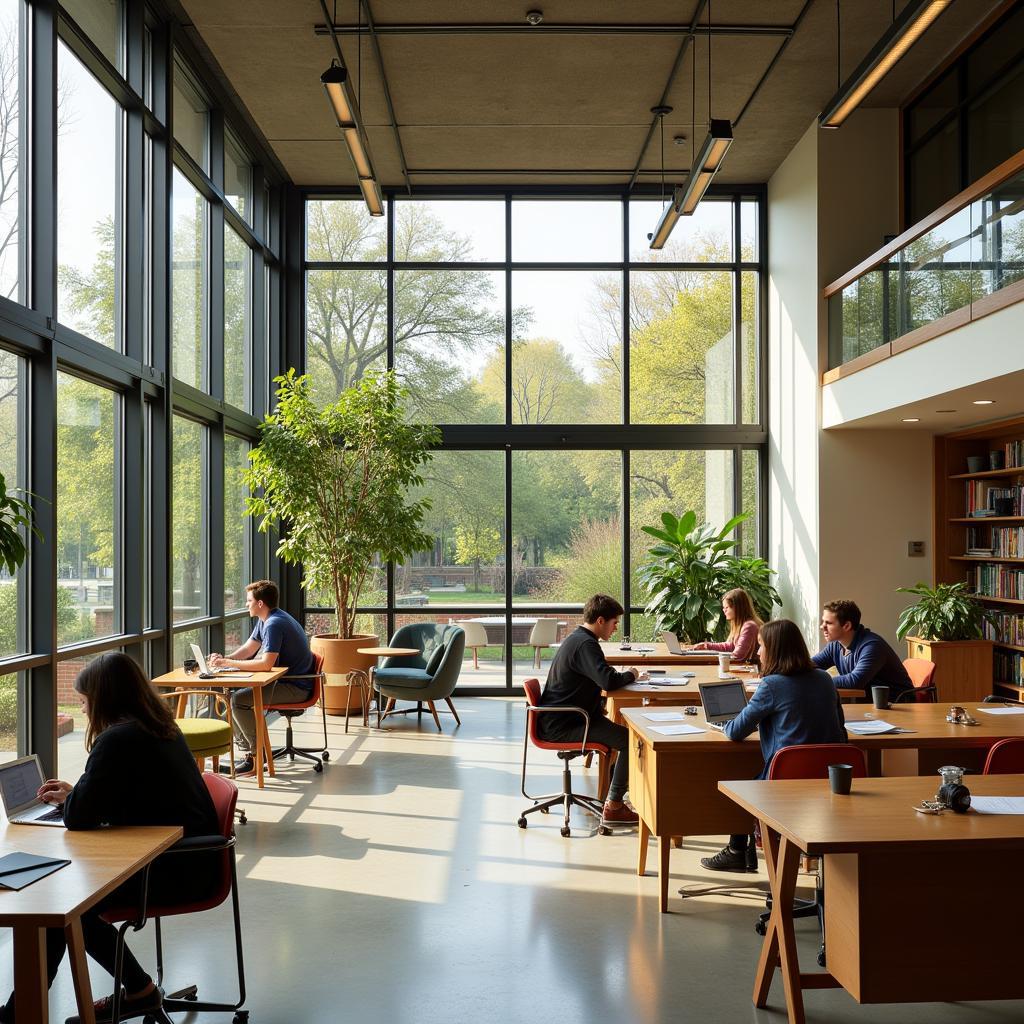Architecture Syllabus Spa – a term often searched by aspiring architects seeking a blend of rigorous academics and a rejuvenating environment. This guide delves into the intricacies of architecture syllabi, particularly within the context of a spa-like learning atmosphere. We’ll explore the benefits, challenges, and key components of such a curriculum.  Architecture students reviewing their syllabus in a spa-like setting
Architecture students reviewing their syllabus in a spa-like setting
Understanding the “Architecture Syllabus Spa” Concept
What exactly does an “architecture syllabus spa” entail? It represents a holistic approach to architectural education, combining demanding coursework with an emphasis on well-being. This approach recognizes that creativity and productivity thrive in environments that promote relaxation and mental clarity. Imagine studying complex structural designs while surrounded by calming scents, natural light, and soothing sounds. This is the essence of the architecture syllabus spa. This approach isn’t about lessening the academic rigor but rather about creating an optimal learning environment. It’s about fostering a space where students can delve into the intricacies of b.arch syllabus spa delhi and truly immerse themselves in their studies.
Key Components of an Architecture Syllabus Spa
A successful architecture syllabus spa integrates several key elements:
- Mindfulness and Well-being: Incorporating mindfulness practices, yoga, or meditation sessions can help students manage stress and improve focus.
- Environmental Design: Creating a calming and inspiring physical space is crucial. This includes natural light, comfortable furniture, and elements of nature.
- Community Building: Fostering a supportive and collaborative learning community encourages peer-to-peer learning and reduces feelings of isolation. Think about group projects in a tranquil setting, promoting teamwork and innovative design solutions. This also includes easy access to resources like details on admission to pg at spa delhi.
 Architecture students working in a studio designed with spa-like elements
Architecture students working in a studio designed with spa-like elements
Benefits of an Architecture Syllabus Spa Approach
The architecture syllabus spa model offers numerous advantages:
- Enhanced Creativity: A relaxed mind is more receptive to new ideas and innovative solutions. The tranquil environment fosters creativity, allowing students to approach design challenges with fresh perspectives. How can you design a sustainable building if you’re constantly stressed? The spa environment allows for clear thinking and innovative solutions.
- Improved Focus: By reducing stress and promoting well-being, students can better concentrate on their studies and achieve greater academic success. Learning about complex subjects like architecture technology in spa requires deep focus.
- Increased Productivity: A positive and supportive learning environment can boost motivation and productivity, leading to higher quality work.
- Reduced Burnout: The demanding nature of architectural studies can lead to burnout. The spa approach helps mitigate this by prioritizing student well-being.
“A calm mind is a fertile ground for architectural innovation,” says renowned architect, Dr. Anya Sharma. “The spa approach nurtures this calmness, allowing students to reach their full creative potential.”
Challenges and Considerations
While the architecture syllabus spa approach holds great promise, there are challenges to consider:
- Implementation Costs: Creating and maintaining a spa-like environment can be expensive, requiring investment in facilities and resources.
- Measuring Impact: Quantifying the benefits of this approach can be difficult, requiring careful evaluation and data collection.
Is an Architecture Syllabus Spa Right for You?
The architecture syllabus spa approach may be particularly appealing to students who:
- Thrive in calm and peaceful environments
- Value holistic well-being
- Seek a supportive and collaborative learning community
- Are interested in exploring the intersection of design and well-being
“Integrating well-being into the curriculum isn’t a luxury, it’s a necessity,” shares leading architectural educator, Professor Michael Chen. “It prepares students not just for professional success, but for a fulfilling and sustainable career.”
Conclusion
The architecture syllabus spa offers a unique and promising approach to architectural education. By prioritizing student well-being and creating a supportive learning environment, this model can foster creativity, enhance focus, and ultimately cultivate a new generation of architects equipped to tackle the complex challenges of the built environment. Consider exploring programs that incorporate these principles and discover the benefits of architecture syllabus spa for yourself. You might want to check out details on aieee b.arch cut off for spa delhi for specific program requirements.
FAQ
-
What is an “architecture syllabus spa”? It’s a holistic approach to architectural education that combines rigorous academics with a focus on student well-being and a spa-like learning environment.
-
What are the benefits of this approach? Enhanced creativity, improved focus, increased productivity, and reduced burnout are some key benefits.
-
What are the challenges of implementing this model? Implementation costs and measuring impact can be challenging.
-
Is this approach suitable for all architecture students? It’s particularly appealing to students who thrive in calm environments, value well-being, and seek a supportive learning community.
-
How can I find programs that incorporate the “architecture syllabus spa” approach? Research architecture schools and programs that emphasize student well-being and have a focus on creating a positive learning environment.
-
How does a spa environment contribute to learning architecture? A calm and relaxing environment reduces stress and promotes focus, allowing students to be more receptive to learning complex architectural concepts.
-
What are some examples of elements found in an architecture syllabus spa? Mindfulness practices, a calming physical space with natural light and comfortable furniture, and a strong sense of community are key elements.
For further assistance, please contact us at Phone Number: 0373298888, Email: [email protected] or visit us at 86 Cầu Giấy, Hà Nội. We have a 24/7 customer service team available to assist you.